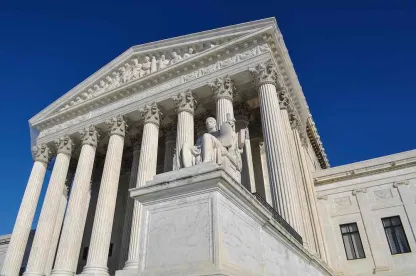The new year begins with one of the most anticipated labor cases on the high court’s docket in decades. On January 10, 2023, the U.S. Supreme Court heard oral argument in Glacier Northwest, Inc. v. International Brotherhood of Teamsters Local Union No. 174 to decide whether the National Labor Relations Act (“NLRA” or the “Act”) preempts state court lawsuits for tort damages caused by unions during strikes. Employers should gain much greater clarity into whether they can seek relief from such conduct via a damages lawsuit. If the U.S. Supreme Court finds that such conduct is not preempted and may be litigated in state court, such a ruling would go far in protecting employers’ interests in contentious labor disputes and potentially shift the balance of power toward employers during these disputes.
Background on Glacier
In Glacier, the company sells and delivers ready-mix concrete to businesses and creates a custom batch of concrete mixing materials based on customer specifications for each job. To create the custom batches, the materials are first mixed in a hopper or barrel and are then moved into a truck that continues to mix the materials until the concrete is delivered to the customer. If a batch of concrete remains in the ready-mix trucks for too long, it could harden and cause damage to the truck’s revolving drum.
Glacier’s truck drivers are represented by Teamsters Local 174. During contract negotiations in August 2017, Local 174 timed their strike to coincide with the scheduled delivery of ready-mix concrete, and at least 16 drivers left trucks that were full of mixed concrete, requiring the Employer to rush to empty the trucks before it hardened and caused damage. While the Employer was able to do so, it incurred considerable expenses and lost product by dumping the concrete in order to avoid truck damage.
The strike ended on August 18, 2017, after a new collective bargaining agreement was ratified. Although the strike had ended, due to rumors that the truck drivers would not work on the next day, August 19, 2017, Glacier sought assurances from the union that the truck drivers would return to work and service a large job that Glacier had scheduled for that day. A Union representative allegedly misrepresented that the truck drivers would return to work and service the job that was scheduled for August 19, 2017. Ultimately, not enough drivers reported for the job and Glacier was forced to cancel it, incurring over $100,000 in losses.
Employer Brings State Law Suit for Property Damage
On December 4, 2017, Glacier filed a complaint in Washington state court for damages in King County Superior Court against the Union for conversion and trespass to chattels, tortious interference with contract, civil conspiracy to destroy its concrete, negligent misrepresentation, fraudulent misrepresentation, and intentional interference with contract. The Union then filed a complaint with the National Labor Relations Board (“NLRB” or “Board”) alleging unfair labor practices for retaliating against truck drivers for engaging in a protected strike.
State Court Holdings
The Union moved to dismiss all of Glacier’s claims for lack of subject matter jurisdiction and failure to state a claim on which relief could be granted, arguing that all claims were preempted by the NLRA. The trial court dismissed the claims related to the August 11 strike, but not the claims that related to the August 19 events. The Union then moved for summary judgment on the remaining claims. The trial court ruled that the strike-related claims were preempted by the NLRA and granted summary judgment for the union on the misrepresentation claims. Glacier appealed and the court of appeals reversed on the preemption issues but affirmed dismissal of the misrepresentation claims. The court of appeals concluded that the destruction of concrete was unprotected conduct under section 7 of the NLRA.
Local 174 petitioned the Supreme Court of Washington for discretionary review of the court of appeals holding that Glacier’s claims were not preempted by the NLRA. Glacier cross petitioned for review of the court of appeal’s holding that affirmed summary judgment dismissal of its misrepresentation claims and intentional interference with contract claims.
The Supreme Court of Washington held that the NLRA preempted Glacier’s tort claims related to the loss of product because the loss was incidental to a strike that was “arguably protected” by section 7 of the NLRA, and that although it was debatable whether the work stoppage was a protected strike, it is at least “arguably protected” and such a determination was reserved for the NLRB. The Supreme Court of Washington affirmed dismissal of Glacier’s misrepresentation claims because the union representative’s promise of future action was not a statement of existing fact on which those claims can be properly based and because the statement was not a proximate cause of Glacier’s losses.
The Parties’ Legal Arguments Before the U.S. Supreme Court in Glacier
The U.S. Supreme Court will now determine whether the NLRA bars state law tort claims against a union for intentionally destroying an employer’s property in the course of a labor dispute.
Glacier argues that the conduct by the Union – intentionally waiting until the trucks were loaded with concrete and then calling the work stoppage – was deliberately timed and intended to destroy company property by leaving the concrete to harden in the mixing drums. It argues such behavior is exactly the kind of conduct that is not preempted by Garmon preemption and falls under the “local feeling exception” to Garmon. Further actual or threatened destruction of property has been held to be a matter for the states and thus the NLRA cannot protect the Union from liability here. Glacier also contends that the Supreme Court of Washington’s decision conflicts with United States Supreme Court precedent including that labor law does not deprive an employer of their legal rights to possession and protection of their property. Glacier points to the U.S. Supreme Court decision in Cedar Point Nursery v. Hassid, 141 S.Ct. 2063 (2021), where it held under the Takings Clause that the interest in union organizing does not override “the importance of safeguarding the basic property rights that help preserve individual liberty,” to support its assertion that if state law tort claims arising out of a union’s intentional destruction of an employer’s property are preempted by the NLRA, such a holding constitutes a Taking (a deprivation of property without just compensation). It points to this decision because the NLRB cannot grant compensation to employers for property damage, just injunctive relief.
The Union argues that the conduct the employees engaged in was “arguably protected” under the Act and any determination on whether the conduct was actually protected must be made by the NLRB. Further, the Union argues that the drivers took reasonable precautions to prevent damage as the trucks were returned to Glacier.
A Glacier Decision Could Affect Labor Relations Moving Forward
Garmon preemption is labor preemption based on sections 7 and 8 of the NLRA, protecting concerted activities in collective bargaining and prohibiting unfair labor practices respectively. See San Diego Building Trades Council Local 2620 v. Garmon, 359 U.S. 236 (1959).
In Garmon, the U.S. Supreme Court noted that its role with regard to preemption was to limit the potential conflict between differing results of the Board and state courts in recognition that Congress entrusted administration of the labor policy for the Nation to a centralized administrative agency, armed with its own procedure, and equipped with its specialized knowledge and cumulative experience. Id. at 242. It held that “when an activity is arguably subject to section 7 or section 8 of the Act, the states as well as the federal courts must defer to the exclusive competence of the Board if the danger of state interference with national policy is to be averted.” Id. at 245.
The U.S. Supreme Court noted two exceptions to Garmon preemption: (1) where the activity regulated was merely a peripheral concern of the LMRA or (2) where the regulated conduct touched interests so deeply rooted in local feeling and responsibility that, in the absence of compelling congressional direction, we could not infer that Congress had deprived the states of the power to act. Id. at 243–44.
The second exception, which is at issue in Glacier involves state jurisdiction over claims to grant compensation for the consequences, as defined by the traditional law of torts, of conduct marked by violence and imminent threats to public order. This exception will likely be discussed in the opinion by the U.S. Supreme Court and whether it applies in this instance. Furthermore, the U.S. Supreme Court will also likely examine what constitutes an “intentional destruction of property” and whether the actions taken by the union fit that definition. Finally, the U.S. Supreme Court may have to decide whether it is the proper forum to make that determination, or whether the issue is reserved for the Board.
How the U.S. Supreme Court decides Glacier will have far reaching implications not only on Garmon preemption, but could also affect areas of labor law where states have granted organized labor and unions rights that exceed federal requirements.
A Glacier Decision Could Impact Employer Property Rights in Pro-Labor States Like California
As we previously discussed here, in Cedar Point, the U.S. Supreme Court invalidated a California labor regulation that required growers to grant union organizers property access, and declared such access rights an unconstitutional taking in violation of the 5th and 14th amendments. Several other California laws and decisions sanction similar union trespass onto private property. Prior to Cedar Point, numerous state court decisions have granted unions access to private property of employers with whom they have a dispute on the theory that such access is required in order to enable labor to communicate its message to the public and to put economic pressure on the employer. Likewise, prior to Cedar Point, California’s statutes have been applied to grant special protections to labor speech and to bar courts from enjoining union trespass on private property. See e.g., Ralphs Grocery Co. v. United Food & Commercial Workers Union Local 8, 55 Cal.4th 1083 (2012); UFCW, Local 324 v. Superior Court of Los Angeles, 83 Cal.App.4th 566 (2000); cf. Waremart Foods v. NLRB, 354 F.3d 870 (D.C. Cir. 2004).
Adding on to Cedar Point, the U.S. Supreme Court’s decision in Glacier could affect state court decisions and potentially grant property owners more reprieve and an additional avenue of attack to enjoin union invasion of an employer’s property. Should the U.S. Supreme Court find a similar rationale in Glacier, that property damage sustained by an employer due to a labor dispute (but without the ability to seek compensation for such damage) constitutes an unlawful taking, there is a potential for employers to not only seek damages, but it could offer a possible leg up for employers seeking injunctive relief to prevent such damage. The Supreme Court’s decision in Glacier has the potential to affect how California State Courts interpret and enforce the Moscone Act and California Labor Code § 1138.1.[i] For example, the Supreme Court’s decision in Glacier, could affect how California State Courts apply the Moscone Act due to the broad use of the term “unlawful” with regard to conduct the Moscone Act does not protect and the minimalist description of such unlawful conduct to include “breach of the peace, disorderly conduct, the unlawful blocking of access or egress to premises where a labor dispute exists, or other similar unlawful activity.”
Following Glacier, there could be numerous issues and arguments for California State Courts to consider. For example, will California State Courts include property damage that may accompany an otherwise lawful activity as “unlawful” under the Moscone Act? Likewise, could this finally motivate California State Courts to issue more injunctions if there is a belief that property damage will occur in order to curb future tort claims against organized labor? Conversely, if the U.S. Supreme Court determines that such state tort claims are preempted by Garmon, would that open the door for California Courts to apply the Moscone Act even more harshly and strictly define what constitutes “unlawful” activity – but exclude intentional property damage? Stay tuned.
Key Takeaways
Employers should gain much greater clarity into whether they can seek relief from such conduct via a damages lawsuit. If the U.S. Supreme Court finds that such conduct is not preempted and may be litigated in state court, such a ruling would go far in protecting employers’ interests in contentious labor disputes and potentially shift the balance of power towards employers during these disputes.
FOOTNOTES
[i] There are two California statutes that restrict the availability of labor injunctions in California. The California Moscone Act (California Code of Civil Procedure section 527.3) prohibits certain labor-related activities on private property from being restrained as long as they are related to a labor dispute and are “lawful.” See Cal. Code Civ. Proc. § 527.3. The Moscone Act limits the state court’s ability to issue preliminary or permanent injunctions that would prohibit any of the conduct described in the section as “lawful.” Id. Importantly, subsection (e) of the Moscone Act states it is not the intent of the section to permit conduct that is unlawful including breach of the peace, disorderly conduct, the unlawful blocking of access or egress to premises where a labor dispute exists, or other similar unlawful activity. Id. Thus, a court may enjoin activity the Moscone Act deems “legal,” when accompanied by unlawful conduct. Id.
The second statute, California Labor Code section 1138.1, limits the authority of state courts to issue an injunction in a labor dispute and establishes several difficult requirements that an employer must overcome to obtain an injunction against a union, including proving with testimony by witnesses:
-
unlawful acts have been threatened and will be committed unless restrained or have been committed and will be continued unless restrained.
-
substantial and irreparable injury to complainant’s property.
-
the relief granted is greater than the injury inflicted upon the complainant by the denial of relief than will be inflicted upon defendants by the granting of relief.
-
no adequate remedy at law.
This statute has effectively prevented employers from obtaining injunctions in many labor disputes.





 />i
/>i

